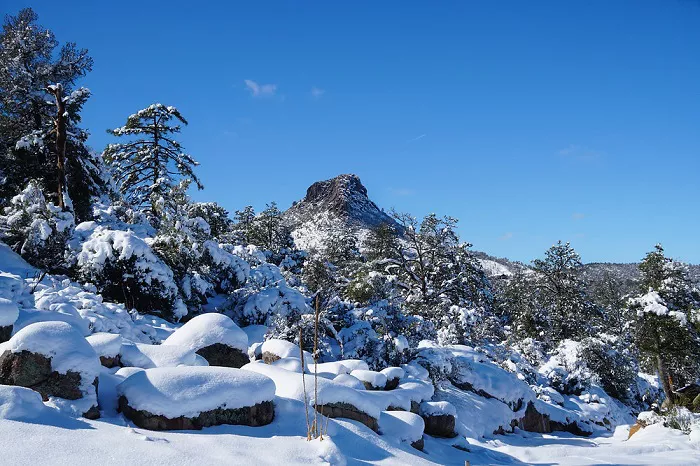Prescott, Arizona, is renowned for its picturesque landscapes, rich history, and vibrant community. Situated at an elevation of approximately 5,400 feet in the Bradshaw Mountains, Prescott experiences a climate that offers a distinct change in weather patterns throughout the year. This article delves into the seasonal variations in Prescott, examining the characteristics of each season to determine if the city truly experiences four distinct seasons.
Spring in Prescott
Temperature and Weather Patterns
Spring in Prescott typically spans from March to May. During this period, temperatures gradually rise, with average highs ranging from the mid-60s°F in March to the mid-70s°F in May. Nighttime temperatures can be cooler, often dipping into the 30s and 40s°F. This transitional phase is characterized by mild days and cool nights, providing a comfortable environment for outdoor activities. citeturn0search1
Precipitation and Snowfall
Spring is one of the driest seasons in Prescott, with March receiving an average of 1.69 inches of precipitation. Snowfall is uncommon during this time, as the city begins to emerge from the colder winter months. citeturn0search5
Flora and Fauna
As spring progresses, the natural landscape of Prescott comes alive. Wildflowers bloom, and the surrounding forests and parks become lush with greenery. This season is ideal for hiking, birdwatching, and exploring the outdoors.
Summer in Prescott
Temperature and Weather Patterns
Summer in Prescott lasts from June to September, with average high temperatures ranging from the low 80s°F in June to the high 80s°F in July and August. Despite being summer, Prescott’s higher elevation provides a respite from the extreme heat experienced in lower desert regions. Even during the hottest months, temperatures rarely exceed 90°F. citeturn0search2
Monsoon Season
From mid-June to mid-September, Prescott experiences the North American Monsoon. This period brings afternoon thunderstorms, increased humidity, and a significant portion of the city’s annual rainfall. July and August are typically the wettest months, with precipitation averaging between 2 to 4 inches per month. citeturn0search0
Outdoor Activities
The summer months are ideal for enjoying Prescott’s numerous lakes, hiking trails, and outdoor festivals. The monsoon rains contribute to the region’s lush vegetation, enhancing the beauty of the landscape.
Fall in Prescott
Temperature and Weather Patterns
Fall, from September to November, is considered one of Prescott’s most beautiful seasons. Daytime temperatures gradually decrease from the 80s°F in September to the 60s°F in November. Nights become cooler, with temperatures often dipping into the 30s and 40s°F. citeturn0search1
Precipitation and Snowfall
Fall sees a reduction in rainfall compared to the summer months. September averages 1.69 inches of precipitation, with amounts decreasing in October and November. Snowfall is rare during this season, but the cooling temperatures signal the approach of winter. citeturn0search5
Seasonal Changes
The fall foliage in Prescott is a highlight, with the surrounding forests displaying vibrant colors. This season is perfect for scenic drives, photography, and enjoying the crisp air.
Winter in Prescott
Temperature and Weather Patterns
Winter in Prescott spans from December to February. During this time, daytime highs average in the 50s°F, while nighttime lows can drop into the 20s and 30s°F. The cooler temperatures create a crisp atmosphere, especially during the early mornings and evenings. citeturn0search1
Precipitation and Snowfall
Winter is the primary season for snowfall in Prescott. The city receives an average of 13 inches of snow annually, with January being the snowiest month, averaging 2.3 inches. Snowfall can occur intermittently, and while it may not accumulate for extended periods, it adds a picturesque touch to the winter landscape. citeturn0search2
Holiday Celebrations
Prescott is known as “Arizona’s Christmas City,” and during the winter months, the town is adorned with festive lights and decorations. The holiday season brings a variety of events, including parades, concerts, and markets, creating a warm and inviting atmosphere despite the cooler temperatures.
Conclusion
Prescott, Arizona, offers a distinctive four-season climate, characterized by mild winters, warm summers, and transitional spring and fall periods. The city’s elevation and geographical location contribute to its unique weather patterns, providing residents and visitors with a diverse and enjoyable climate throughout the year. Whether you’re seeking the vibrant blooms of spring, the monsoon rains of summer, the colorful foliage of fall, or the festive charm of winter, Prescott delivers a full spectrum of seasonal experiences.

